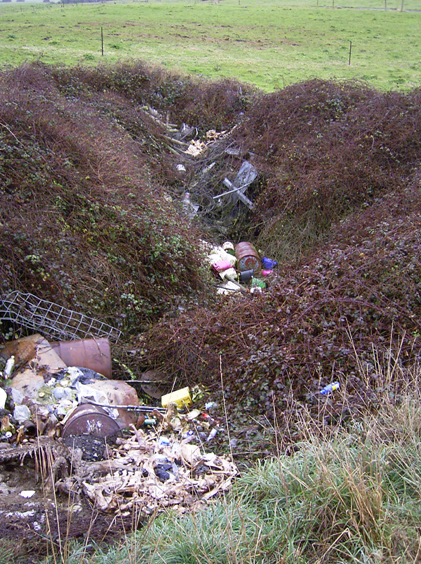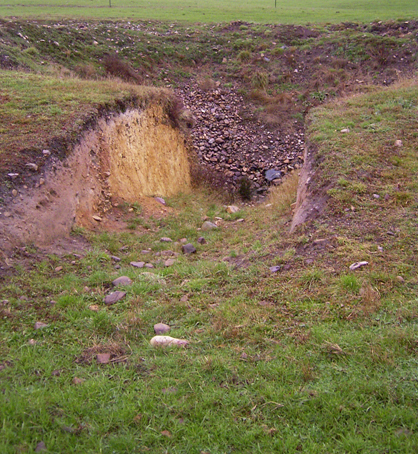Enclosed depressions are the archetypal karst landform, testimony to the presence of underground voids into which overlying materials are prone to subside or collapse. They come in an infinite variety of shapes and sizes, with a rich nomenclature to suit.
Americans refer to 'sinkholes', meaning any karstic depression or a place where a stream or river goes underground into a cave or filtering through an impenetrable choke (Field 1999). In the UK they talk of 'kettleholes', 'shakeholes' and 'swallow holes'. The Slavic term 'doline' is popular in Australia, although 'sinkhole' has a strong foothold in Tasmania (Kiernan 2002). Many other national and regional variants exist.
Other Slavic terms such as 'uvala' (compound feature produced by coalescing dolines) and 'polje' (large, flat-floored depression with an area of up to 1,000 km2) have also ingratiated their way into the local vocabulary. In Tasmania at least this has spawned an inordinate number of heated discussions about whether such-and-such a feature is a polje or whatever. Personally, I'd be happy to see greater use of descriptive labels (eg. 'large flat-floored karstic depression') at the expense of Eurocentric ones that potentially gloss over genetic and morphological differences 'down under'.
Polje literally means 'field', hinting at one use of the humble sinkhole. The flat alluviated floors of Slavic poljes were evidently suited to agriculture. Similar features in New Guinea, Mexico and elsewhere support villages and gardens that would be impractical on the surrounding rugged topography. More prosaically, sinkholes in metropolitan Mt Gambier provide public space complete with terraced slopes and flowerbeds. One rather modest sinkhole at Mole Creek has been adapted for use as a poultry pen, the sloping sides collaborating with a wobbly fence to confine the chooks.
A more ambitious endeavour is Forestry Tasmania's development of what the agency's web site describes as 'an intriguing eco-tourism experience ... set in the evocative surrounds of a giant blackwood sinkhole'. The web site goes on to say that the site 'features a thrilling 110-metre slide down to the swamp-floor ... a series of "maze-like" paths and fascinating art installations inspired by the swamp ecology.' There is also a 'stylish Visitor Centre [that] satisfies the other senses with a brasserie serving delicious meals and beverages, and stunning, not-to-be-missed views of the blackwood swamp from a cantilevered look-out.' This is Dismal Swamp, a 600 ha karstic depression that some argue is Tasmania's (Australia's?) best polje. In fact the question of whether or not Dismal Swamp is a polje or even karstic preoccupied Tasmania's Resource Planning and Development Commission in 1998. This was the culmination of a bizarre series of events related to mineral exploration and the Tasmanian Regional Forest Agreement. Anyone interested in this story of the use and abuse of science for political purposes should read Sharples (1999).
Tasmanian Premier Paul Lennon opened Dismal Swamp in September 2004. The slide was indeed thrilling, so much so that it was closed shortly afterwards because people were hurtling out of control and getting injured. The slide was reopened in September 2005 with new safety measures including helmets and a sleeping bag-like sheath of protective fabric to be worn by riders. Despite this hiccup, Dismal Swamp will probably do quite well business-wise. The Winter 2005 edition of Forestry Tasmania's glossy 'Branchlines' magazine states that Lonely Planet writer Tom Hall ranks Dismal Swamp as one of the top five destinations in the world for 2005, whatever that means.
 |  |  |
| Sinkhole, Florentine Valley, Tasmania. This feature was not recognised as a karstic depression until the onset of winter rains, after it was logged and burnt. Photo: Nathan Duhig | Sinkhole abuse in Northern Tasmania. Photos: Nathan Duhig | |
The emphasis on fun belies a more serious purpose at Dismal Swamp, that of enhancing Forestry Tasmania's image, particularly with regard to sustainable forest management. Thus, the Forestry Tasmania Dismal Swamp web page talks a lot about blackwood and other timbers but not much about karst, other than a rather curious claim that Dismal Swamp is 'believed to be the only blackwood sinkhole in the world, formed over thousands of years by dissolving dolomite'. The published version of the Premier's speech at the opening makes no mention of karst, stating that 'Dismal Swamp ... is really about telling the story of blackwood and the key role its sustainable management has played and will continue to play, in the history of this unique area.' Karsties who have visited the place generally comment on the limited extent to which karst is covered in the interpretation.
The detractors of what some refer to as 'Dismal Land' generally have a more fundamental objection, namely that the development shouldn't be there in the first place, because of impacts to the forest ecology and Dismal Swamp as a karst landform. I should say at this point that I have not been to Dismal Swamp since the Forestry Tasmania development, nor do I necessarily object or support what has been done. I'd prefer to experience the place without the encumbrance of a giant slide and other tourist infrastructure. Then again, if I had the choice I'd probably prefer to experience a show cave prior to it being developed for this purpose. And notwithstanding some important differences in the style of presentation, show caves are not all that dissimilar to Dismal Swamp in that they are business enterprises in sensitive environmental settings.
The issue of adverse environmental effects was debated before the Resource Management & Planning Appeals Tribunal, part of Tasmania's planning approvals system. The Environment Association objected to the proposal on various grounds including issues to do with management of stormwater and sewage, slope stability and soil erosion, leaching of toxic metals from treated wood used in the construction, etc. They considered Dismal Swamp as an inappropriate site for a development that was ostensibly concerned with 'showcasing' excellence in forest management (Hunter 2004).
With regard to karst-related issues, the Tribunal heard evidence from Nathan Duhig of the Forest Practices Board. Duhig did not support the argument that raised walkways and other infrastructure on piles sunk into the floor of the depression would interfere with the karstic hydrology, stressing instead the sensitivity of the characteristic steep but short marginal slopes. The Tribunal was persuaded that a proposed access involving the construction of a road across the slopes of the depression should be replaced by an elevated or suspended access. In relation to sewage, it noted that the proposal provided for this to be initially taken away and when it reached the 50,000 visitor per year level, to be directed to an approved on-site sewage treatment plant outside the polje. The Tribunal considered that the proposal to locate the visitor centre, car park, and facilities above and outside the rim of the polje, was appropriate.
No discussion of acts of omission and commission affecting sinkholes would be complete without touching on their use for dumping. One can see the attraction: sinkholes are generally closer than the tip, are open all hours, do not attract Council fees and putting rubbish in them helps fill unwanted holes. The practice appears to be endemic in agricultural karstlands. Water-filled sinkholes around Mt Gambier contain an amazing array of junk, including agricultural implements, rolls of wire, garden gnomes and god knows what else. Sinkholes in cleared land around Mole Creek are more likely to contain domestic rubbish, animal carcases or drums labelled for petroleum products, veterinary products and herbicides. It's great to see that in some areas projects to clean up and revegetate sinkholes and caves are gaining momentum (Bourne & Ashby 2005), although we are yet to see substantial progress on this front at Mole Creek.
One could be forgiven for assuming that the practice of sinkhole dumping was officially condoned at Mole Creek. As late as the 1990s a complex of large sinkholes on the Mayberry-Sassafras divide was managed as a local government refuse disposal area. The site overlies the presumed location of a confirmed subsurface drainage connection between Circular Ponds and springs on Sassafras Creek. The land was handed over to the Parks & Wildlife Service as part of the Great Western Tiers Conservation Area in 1996, the tip having been covered over some years previously. Old habits die hard and illegal dumping of car bodies, fridges and other rubbish is an ongoing problem at this site. I draw attention to Council's role because this may have helped entrench attitudes that persist in some parts of the community. I can vouch for the fact that Meander Valley Council is now acutely aware of karst issues.
Filling sinkholes with rocks and soil is also common. In some cases this is done in response to the risk that deep holes in ground pose to stock - one Mole Creek farmer refers to sinkholes by the name of particular cows that he has winched out of them. Moreover, flat ground is easier to farm than bumpy ground, so it's no wonder that some landowners make a habit of pushing the humps into the hollows.
Getting rid of sinkholes can be a frustrating business. Divers exploring The Shaft, an awesome underwater cavity that bells out beneath a modest hole in a paddock at Mt Gambier, would appreciate the futility of trying to fill it. One farmer had a jolly good try, as shown by the cone of rubble, the top of which is still 30 m underwater. A landowner at Loatta in Tasmania would probably sympathise, telling the Forest Practices Tribunal that he had poured hundreds of cubic metres into a hole on his property without apparently reducing its depth to any significant degree. Some places just weren't meant to be flat; visit the following web site if you need to be convinced: www/stoptranspark.org/sinkhole.htm.
What options exist for reforming current approaches to management of sinkholes, particularly in off-reserve contexts? Education would seem to have a role. Is it too simplistic to suggest that if the people who chuck rubbish down holes understood that this will affect the quality of groundwater used by them or others, then they'd stop? 'Looking after karst' type posters and guides have been produced in America (eg. Zokaites 1997). A case exists to produce similar products in Australia. Sinkhole clean-up projects are likely to be valuable, providing tangible improvements in environmental conditions while raising community awareness if accompanied by appropriate publicity.
Should landowners be paid to clean up sinkholes on their properties? This might be controversial but there is little doubt that financial incentives would be a catalyst for action. Should sinkhole dumping be illegal, if it isn't already? Polluting a watercourse (surface or subterranean) is illegal under environmental legislation in Tasmania and elsewhere. But it may be hard to argue the case that a particular sinkhole constitutes a watercourse within the meaning of the relevant statute. Maybe sinkhole dumping would be better addressed through local government planning controls. These and other options are worth considering.
References
Bourne, S. & Ashby, C., 2005; Rubbish, Rubbish, Rubbish, ACKMA Journal, 59: 42-43.
Field, M.S., 1999; A Lexicon of Cave and Karst Terminology with Special Reference to Environmental Karst Hydrology, US Environmental Protection Agency, Washington.
Hunter, D., 2004; Dismal Swamp Polje, 'Ecotorism Development', ACKMA Journal, 54: 22.
Kiernan, K., 2002; Forest Sinkhole Manual, Forest Practices Board, Hobart.
Sharples, C., 199; The Dismal Swamp polje of northwest Tasmania: a case study in geo-conservation, Cave & Karst Management in Australiasia 13.
Zokaites, C., 1997; Living on Karst: A Reference Guide for Landowners in Limestone Regions, Cave Conservancy of the Virginias, Richmond, USA.